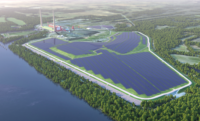The Tennessee Valley Authority’s board of directors on Aug. 21 unanimously approved its 2015 plan for regional energy that reflects less dependence on coal-fired generation, more focus on natural-gas generation and renewable resources, and plans to use energy efficiency as a supply resource.
William Johnson, president and CEO of the federal power producer, said that the integrated resource plan, with its intention to retire coal-fired plants, will bolster TVA's efforts to meet requirements of the U.S. Environmental Protection Agency’s Clean Power program.
Under the plan, TVA could retire more coal-fired units and add 700 MW to 2,300 MW of gas-fired generation by 2023 and up to 5,500 MW by 2033.
The utility projects energy-demand growth of 1% per year, peak-demand growth of a 1.3% per year and a need for a 15% reserve margin. Currently, energy demand is about 160 TWh/year, with a peak load of 30,000 MW.
“A key challenge is projecting how much power we will need, when and where, and identifying the optimum mix of energy resources to meet future power demand,” according to the TVA's Integrated Resource Plan.
“This is a compass, not a GPS,” said Joe Hoagland, TVA’s vice president for consumer relations. “It is a directional document that does not make a specific asset decision, but will depend on circumstances to show where we need to go.”
Besides reducing dependence on coal-fired generation, TVA determined there is no need for additional resources during the 20-year planning time frame, he added. The plan does not provide for any new baseload capacity beyond the Watts Bar Nuclear Unit 2 in Tennessee, set for completion this year, and planned upgrades of the Browns Ferry plant in Alabama.
The TVA Public Power Association—TVA’s distribution utilities and the Southern States Power Cooperative—endorsed the plan.
TVA approved the plan after listening to more than two hours of public comment, some from environmental groups that primarily asked TVA to consider adding more renewable resources and to adopt higher rates of energy efficiency.
The Southern Alliance for Clean Energy said TVA should boost its current energy-efficiency budget by at least 50% and develop a more robust energy-efficiency-planning process. To optimize TVA’s investments in clean energy resources, it should create a robust renewable-energy-development plan, the environmental group added.
TVA's improvements in air quality across the power system have reduced carbon dioxide emissions about 30% from 2005 levels. By 2020, TVA expects to be nearly 40% below 2005 levels.




Post a comment to this article
Report Abusive Comment